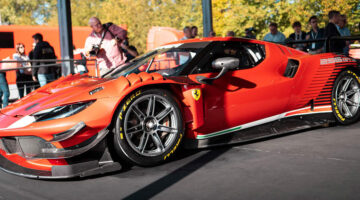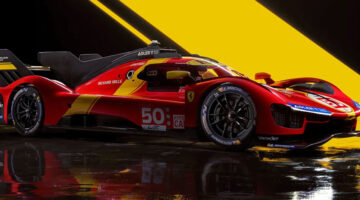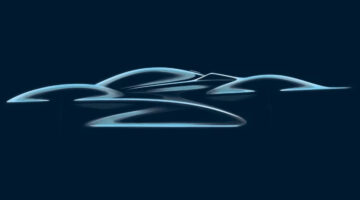Red Bull is the latest team to reveal its 2018 race car, seen here in the team’s usual pre-season development livery. Called the RB14, Red Bull is hoping to be back in title contention after a suite of detail changes to the chassis and with an improved Renault-sourced power unit.
2017 was a year of great change in the Formula 1 world championship. Headlined by faster and more aerodynamically aggressive cars compared to previous years, the eyes of the world were peeled to see if a new F1, no longer under the rule of Bernie, could begin to answer the call of fans and critics. In 2018 the changes have been less substantial, but still aim to bring further excitement to the sport with a continued effort to improve in-race overtaking and a renewed focus on louder, more dramatic engines.
With such a large technical regulation change in the preceding year, you’d be forgiven for thinking that not much will have changed, but instead the governing body of F1, the FIA, deemed it necessary to take the first steps towards introducing a closed cockpit.
The result is the much-contrived ‘halo’, a three-pronged section that sits over the driver’s head, further protecting him or her from race debris or other moving objects that could harm the driver. Although it is ridiculous to object to a new feature whose raison d’être is based purely on improving safety, it’s the execution of the halo that has been a major point of controversy leading up to the 2018 season.
Each of the teams will of course be subject to these new rule changes, but elsewhere, the major point of difference this year is the shake-up of where each team will source their power units. After three disastrous years running the under-performing, unreliable Honda unit, McLaren has switched to a vastly improved Renault engine that will also feature in Renault’s factory team and Red Bull.
To stay in the game, Honda’s powerplant will now nestle under the engine covers of the Toro Rosso cars, playing a development role for Red Bull’s eventual adoption of the Japanese engine in 2019. Ferrari and Mercedes will keep hold of their respective engines, while Renault is hoping its 2018-spec engine will have closed the gap on its rivals.
Despite winning three races in the 2017 season, Red Bull has been hamstrung by the underpowered Renault power unit, explaining its desire to move on from the French brand. For now though, if Renault’s efforts have paid off, Red Bull’s typically impressive chassis could bring back a third championship contender in 2018. Alfa Romeo will also make a return to the sport, although unlike its Italian Ferrari cousin will be a title sponsor of Sauber, rather than a standalone team.
The cars
Red Bull
The last few seasons have been a source of continued frustration for the Red Bull team, saddled with an underperforming power unit sourced from Renault. Frustrations last year bubbled over between team and engine supplier, resulting in 2018 being the final season of the pairing before Red Bull’s move to Honda engines from 2019.
Red Bull’s support team, Toro Rosso, has already made the controversial move to Honda, but after three long years at the rear of the field any instant improvements in the Red Bulls on last year’s results are far from a foregone conclusion. So far the RB14 has been launched in the team’s usual pre-season development livery, with the real thing to be revealed next week when testing kicks off in Catalunya.
In the cockpit will be the same pairing of Daniel Ricciardo and Max Verstappen from the last couple of years. Both drivers have shown considerable talent so if their cars are up to it, expect to see them closer to the front end of the field more consistently this year.
Williams
Williams was team number two to show off its 2018 F1 entry called FW41. Under the stewardship of Williams’s chief technical officer, Paddy Lowe, and head of aerodynamics, Dirk de Beer, Williams is hoping to put its disappointing 2017 season behind it and return to its usual place further up the mid-field. Like all other teams, Williams has had to integrate the controversial halo into the design, looking more integrated than on the HAAS revealed previously.
A similar Martini livery remains, now sitting with more black bodywork below the iconic white paint. Don’t be deceived by the lack of the FW40’s engine cover-mounted fin or its aerofoil: these aerodynamic add-ons will likely make an appearance after the first round of testing.
Canadian driver Lance Stroll will maintain his driver’s seat, with the retirement of Massa leaving the door open for Sergey Sirotkin to fill the second seat. Meanwhile, F1 and WRC veteran Robert Kubica has also been signed as a development and backup driver.
HAAS
HAAS’s 2018 contender was the first car to be revealed this year, with the American team hoping to mirror the relative successes it had against tail-end rivals in 2017. The cars will once again run Ferrari power units, and like the Williams above, have a significantly reduced fin atop the engine cover as the biggest contrast compared to last year’s car.
The livery also remains much the same as last year, featuring the corporate colours of the team’s namesake HAAS Automation. The team had a focus on removing as much weight as possible to then replace it with ballast, bringing it back up to the legal weights. This allows HAAS the ability to place ballast in the car in opportune positions to better control the weight distribution. Romain Grosjean and Kevin Magnussen are poised to keep their seats, too.
This article originally appeared at evo.co.uk
Copyright © evo UK, Dennis Publishing







